

Welcome to the first monthly issue of the NRAO eNews! With this debut issue of NRAO eNews, our Newsletter is transitioning from a hardcopy, quarterly publication distributed via the U.S. Mail to an electronic, monthly publication distributed via e-mail and the World Wide Web. Through the NRAO eNews, we are striving to more effectively and frequently communicate with the science community; to help you quickly locate the NRAO news and information that is most important to you and your science; to deliver NRAO news in smaller, more readable installments; and to reduce production costs. An annual NRAO Newsletter archive will be published in hardcopy format for our institutional subscribers beginning in January 2009. These annual archival issues will contain all eNews content published in the previous calendar year. Let us know what you think and how we can improve NRAO eNews. And thank you for your continued interest in the NRAO!
Mark Adams, Editor
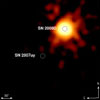 The Birth of a Supernova Supernovae represent the explosive death of the most massive stars in the Universe. They live fast and die young, often within just a few million years. These explosions give birth to neutron stars and black holes, and fuel galaxy evolution through the injection of heavy elements and mechanical energy. Read more...
The Birth of a Supernova Supernovae represent the explosive death of the most massive stars in the Universe. They live fast and die young, often within just a few million years. These explosions give birth to neutron stars and black holes, and fuel galaxy evolution through the injection of heavy elements and mechanical energy. Read more...
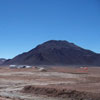 ALMA Construction Continues This quarter marks the tenth anniversary of the approval by the National Science Board of the ALMA Design and Development program, which led to the provisional acceptance of the first prototype antenna from VertexRSI in March 2003. As of June, there are nine production ALMA antennas in Chile, including five production 12m antennas from VertexRSI and four from Mitsubishi Electric Co. (Melco). Read more...
ALMA Construction Continues This quarter marks the tenth anniversary of the approval by the National Science Board of the ALMA Design and Development program, which led to the provisional acceptance of the first prototype antenna from VertexRSI in March 2003. As of June, there are nine production ALMA antennas in Chile, including five production 12m antennas from VertexRSI and four from Mitsubishi Electric Co. (Melco). Read more...
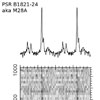 GUPPI First Light On April 17, the team working on the new GBT pulsar backend as part of the CICADA project (Configurable Instrument Collaboration for Agile Data Acquisition) achieved first light with GUPPI (Green Bank Ultimate Pulsar Processing Instrument). GUPPI is based on the open-source FPGA-based technologies developed by the CASPER group at U.C. Berkeley. Read more...
GUPPI First Light On April 17, the team working on the new GBT pulsar backend as part of the CICADA project (Configurable Instrument Collaboration for Agile Data Acquisition) achieved first light with GUPPI (Green Bank Ultimate Pulsar Processing Instrument). GUPPI is based on the open-source FPGA-based technologies developed by the CASPER group at U.C. Berkeley. Read more...
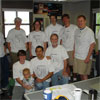 GBT Dynamic Scheduling System Beta Release The first schedule of the Green Bank Telescope’s prototype Dynamic Scheduling System (DSS) was made June 1, 2008. The GBT will be scheduled using the DSS for the 08B trimester (June 1 - Sept 30, 2008). Read more...
GBT Dynamic Scheduling System Beta Release The first schedule of the Green Bank Telescope’s prototype Dynamic Scheduling System (DSS) was made June 1, 2008. The GBT will be scheduled using the DSS for the 08B trimester (June 1 - Sept 30, 2008). Read more...
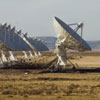 EVLA Progress Antennas continue to be retrofitted to the EVLA design at the rate of six antennas per year. A total of 15 antennas are now used in scientific observations and account for 52.9% of all antenna hours used in observations. The electronics outfitting of the 16th antenna is underway, and the mechanical overhaul of the 17th antenna has begun. Read more...
EVLA Progress Antennas continue to be retrofitted to the EVLA design at the rate of six antennas per year. A total of 15 antennas are now used in scientific observations and account for 52.9% of all antenna hours used in observations. The electronics outfitting of the 16th antenna is underway, and the mechanical overhaul of the 17th antenna has begun. Read more...
(Photo by JMarkStrong.com)
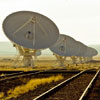 Observing with the VLA-EVLA Transition Array Work to find a post-processing solution to the aliasing problem, which primarily affects the narrower spectral line bandwidths, is continuing. Please consult the special aliasing section on the EVLA returns page for the latest news. Read more...
Observing with the VLA-EVLA Transition Array Work to find a post-processing solution to the aliasing problem, which primarily affects the narrower spectral line bandwidths, is continuing. Please consult the special aliasing section on the EVLA returns page for the latest news. Read more...
(Photo by JMarkStrong.com)
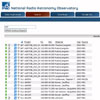 NRAO Data Vault Available Users of NRAO telescopes now have more options to find relevant data in the NRAO archive with the release of the "Data Vault" interfaces. The new features were selected based on nearly 100 survey responses from the user community collected over the past year, coupled with a desire to provide search services from a Google-like text box. Read more...
NRAO Data Vault Available Users of NRAO telescopes now have more options to find relevant data in the NRAO archive with the release of the "Data Vault" interfaces. The new features were selected based on nearly 100 survey responses from the user community collected over the past year, coupled with a desire to provide search services from a Google-like text box. Read more...
 VLBA Principal Scientist Appointed I am very pleased to announce that Jim Ulvestad has agreed to serve as Principal Scientist for the VLBA. In this position, Jim will bring his well-known expertise and eloquence to bear as the primary science advocate for the VLBA to the astronomical community. Read more...
VLBA Principal Scientist Appointed I am very pleased to announce that Jim Ulvestad has agreed to serve as Principal Scientist for the VLBA. In this position, Jim will bring his well-known expertise and eloquence to bear as the primary science advocate for the VLBA to the astronomical community. Read more...
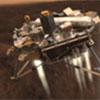 The GBT Supports the Phoenix Mars Lander Mission The Green Bank Telescope (GBT) supported the successful landing of the NASA Phoenix Mars Lander on May 25, directly observing radio frequency transmissions from the lander. Phoenix is the first spacecraft to land in Mars’ polar region and study its landscape, subsurface ice, and minerals. Read more...
The GBT Supports the Phoenix Mars Lander Mission The Green Bank Telescope (GBT) supported the successful landing of the NASA Phoenix Mars Lander on May 25, directly observing radio frequency transmissions from the lander. Phoenix is the first spacecraft to land in Mars’ polar region and study its landscape, subsurface ice, and minerals. Read more...
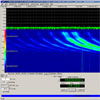 Satellite Downlink Coordination & the Phoenix Mission On March 13, 2008, a team from the NASA JPL Phoenix Mars Lander Project visited NRAO Green Bank to conduct a trial run in preparation for the May Entry, Descent, and Landing (EDL) phase of the Phoenix Mars Lander Mission. Read more...
Satellite Downlink Coordination & the Phoenix Mission On March 13, 2008, a team from the NASA JPL Phoenix Mars Lander Project visited NRAO Green Bank to conduct a trial run in preparation for the May Entry, Descent, and Landing (EDL) phase of the Phoenix Mars Lander Mission. Read more...
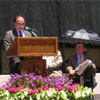 The Pete V. Domenici Science Operations Center The NRAO's Array Operations Center in Socorro officially became the Pete V. Domenici Science Operations Center in a ceremony attended by its namesake on May 30. Pete Domenici, New Mexico's longest-serving U.S. Senator, is retiring next January after 36 years in the Senate. Read more...
The Pete V. Domenici Science Operations Center The NRAO's Array Operations Center in Socorro officially became the Pete V. Domenici Science Operations Center in a ceremony attended by its namesake on May 30. Pete Domenici, New Mexico's longest-serving U.S. Senator, is retiring next January after 36 years in the Senate. Read more...
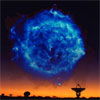 NRAO Scholarships Awarded Two astronomy students from the Universidad de Chile — Andrea Silva and Cinthya Herrera — were awarded scholarships by the NRAO to attend the Eleventh Synthesis Imaging Workshop in Socorro, NM, from 10 - 17 June 2008. Read more...
NRAO Scholarships Awarded Two astronomy students from the Universidad de Chile — Andrea Silva and Cinthya Herrera — were awarded scholarships by the NRAO to attend the Eleventh Synthesis Imaging Workshop in Socorro, NM, from 10 - 17 June 2008. Read more...
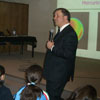 ALMA Presentations in Chile Mauricio Pilleux, NRAO Chilean Business Manager and North American ALMA Deputy Project Manager (Technical), has recently given several talks about ALMA for members of the public in Chile, including doctors, university, and school students in the cities of Valdivia and Santiago. Read more...
ALMA Presentations in Chile Mauricio Pilleux, NRAO Chilean Business Manager and North American ALMA Deputy Project Manager (Technical), has recently given several talks about ALMA for members of the public in Chile, including doctors, university, and school students in the cities of Valdivia and Santiago. Read more...

The National Radio Astronomy Observatory is a facility of the National Science Foundation operated under cooperative agreement by Associated Universities, Inc.
Subscribe | Unsubscribe